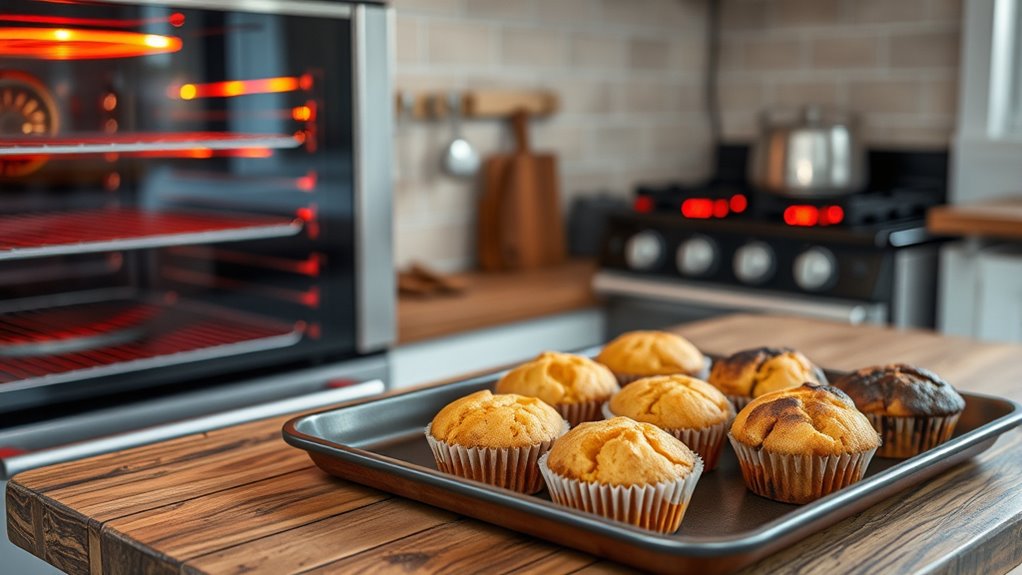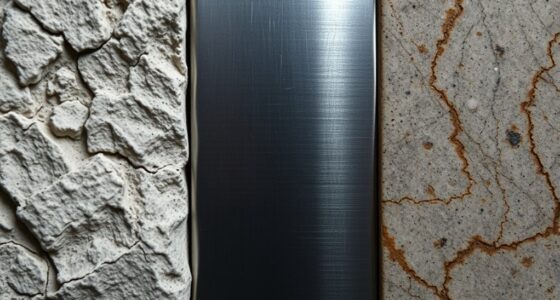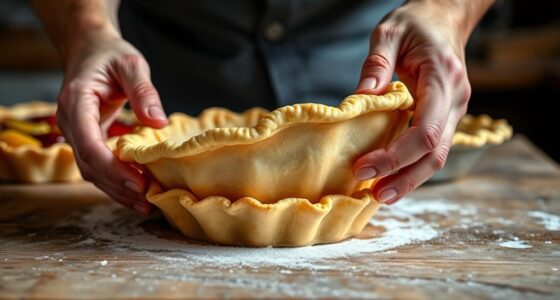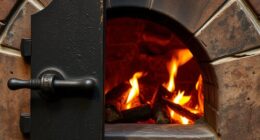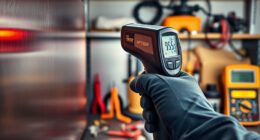To troubleshoot high heat issues quickly, turn off the oven, crack the door open, and let it cool for a few minutes while monitoring the temperature with an oven thermometer. For low heat problems, raise the temperature slightly or bake longer, checking frequently. Adjusting rack placement and using tools like baking stones can also help distribute heat more evenly. Keep experimenting with these tips to improve your results—more helpful solutions are just ahead.
Key Takeaways
- Check oven calibration and adjust temperature settings to match actual heat levels accurately.
- Use an oven thermometer to monitor and correct hot spots or uneven heating promptly.
- For high heat issues, turn off the oven, crack the door open, and let it cool briefly before resuming baking.
- Lower oven temperature or reduce baking time for over-heating to prevent burnt edges and uneven browning.
- For underheating, preheat thoroughly, increase temperature slightly, or place baked goods on a preheated stone for better heat distribution.
Recognizing Signs of Overly Hot Ovens and How to Cool Them Down Quickly
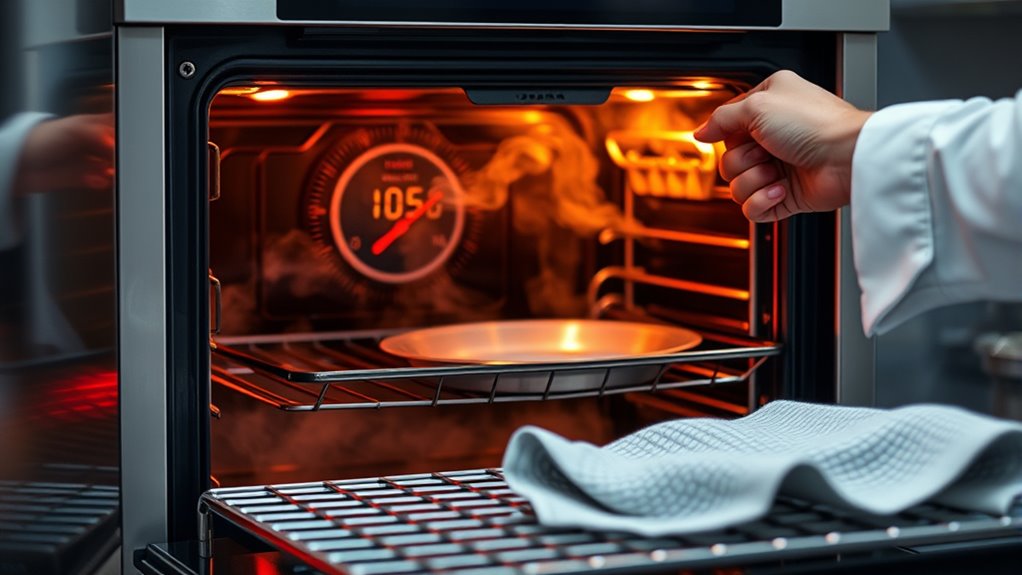
If your baked goods are browning too quickly or burning on the outside before they’re fully cooked inside, your oven might be too hot. First, check your oven calibration; an inaccurate setting can cause uneven heating. Poor heat distribution often results in hot spots, which can lead to uneven baking and burnt edges. To cool it down quickly, try turning the oven off and cracking the door open slightly to release excess heat. Using an oven thermometer can help you monitor the actual temperature and adjust accordingly. If your oven consistently runs hot, consider recalibrating it or scheduling a professional inspection. Proper heat distribution and accurate calibration ensure your baked goods cook evenly and prevent over-browning. Additionally, understanding the refrigeration cycle in your oven’s heating elements can help identify whether the heating components are functioning correctly and contributing to uneven temperatures.
Adjusting Baking Times and Temperatures for Underheating and Overheating
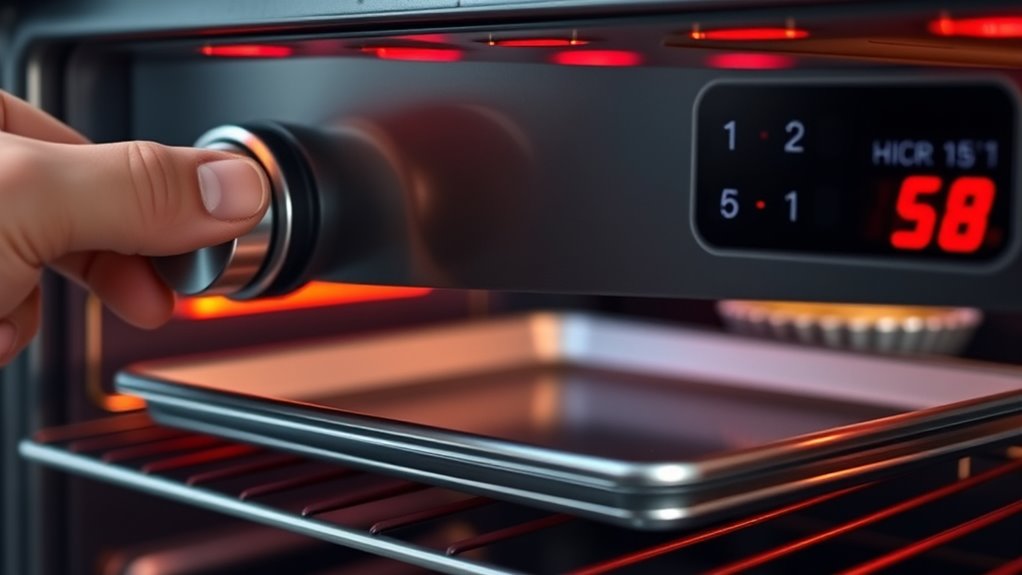
When your baked goods come out underdone or overdone despite following the recipe, adjusting your baking times and temperatures can make a significant difference. First, check your oven calibration—an uncalibrated oven can cause inconsistent results. Next, consider your baking vessel choices; darker pans absorb more heat, while glass or lighter pans reflect it. To fix underheating, try increasing the temperature by 15-25°F or extending baking time slightly. For overheat issues, lower the oven temperature or reduce baking time. Keep these tips in mind:
- Calibrate your oven regularly for accurate temperatures.
- Choose appropriate baking vessels suited for your recipe.
- Adjust temperature settings in small increments.
- Monitor baking times closely and use a timer for precision.
- Remember that oven calibration can significantly impact baking outcomes, so keep it up to date for consistent results.
Making these tweaks ensures your baked goods come out perfectly every time.
Troubleshooting Cracks, Burnt Edges, and Uneven Baking With Temperature Tweaks
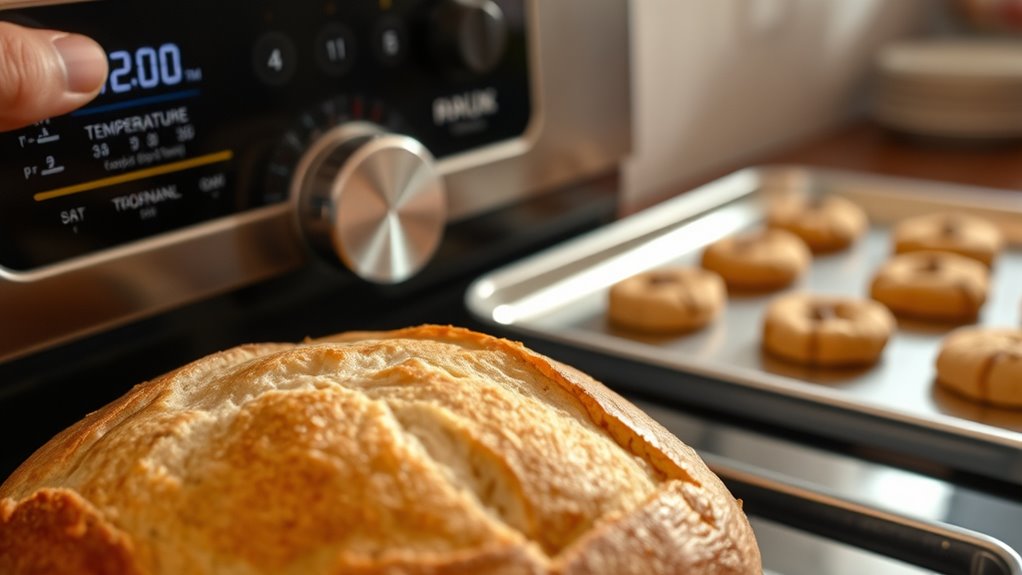
Adjusting your oven temperature can often resolve common baking issues like cracks, burnt edges, and uneven results. Start by checking your oven calibration; an inaccurate thermostat can cause hot spots or uneven heat distribution. If your oven runs hot, lower the temperature slightly to prevent burnt edges. Using a baking stone helps distribute heat evenly, reducing cracks and uneven browning. Ensure the baking stone is thoroughly preheated to create a stable baking surface. If edges burn faster than the center, try reducing the temperature or moving the baking rack to a higher position. Small tweaks in oven temperature, combined with proper calibration and the use of a baking stone, can considerably improve your baked goods’ appearance and texture, leading to more consistent results. Additionally, understanding your oven’s unique heat patterns can help you optimize baking conditions and achieve better outcomes.
Quick Fixes for Raw or Underbaked Centers in Different Oven Conditions

Under different oven conditions, raw or underbaked centers often result from uneven heat distribution or insufficient baking time. To fix this quickly, start by checking your oven calibration; uneven temps can cause cold spots. Next, adjust your baking stone placement to ensure even heat transfer—place it on the middle rack for consistent heat. If your oven runs cool, increase the temperature slightly or extend baking time. Conversely, if it’s too hot, lower the heat or cover the top with foil to prevent overbaking. Using these steps helps address uneven heat issues immediately. Also, consider rotating your baked goods halfway through. Ensuring proper heat distribution is crucial for even baking, regardless of your oven’s current condition.
Preventative Tips to Maintain Consistent Oven Temperatures During Baking

Maintaining consistent oven temperatures starts with proper calibration and regular maintenance. First, ensure your oven is accurately calibrated by using an oven thermometer; many built-in thermostats can be off by several degrees. Recalibrate as needed to keep temperatures precise. Additionally, check the thermal insulation around your oven; good insulation minimizes heat loss and prevents temperature fluctuations. Keep oven doors sealed tightly and avoid opening them frequently during baking, as this causes temperature drops. Regularly clean and inspect door seals and vents to prevent heat leaks. Using an oven with well-maintained thermal insulation and calibrated settings helps maintain steady temperatures, reducing the risk of uneven baking. Proper oven maintenance can also extend the lifespan of your appliance. Consistent oven performance is key to achieving reliable, high-quality results every time.
Frequently Asked Questions
How Can I Tell if My Oven’s Temperature Gauge Is Accurate?
You can check your oven’s temperature accuracy by using an oven thermometer placed inside. Preheat your oven to a specific temperature, say 350°F, and compare the thermometer reading to your oven’s gauge. If they don’t match, you might need an oven calibration. Regularly testing your oven’s temperature accuracy helps guarantee consistent baking results and prevents issues caused by inaccurate temperature readings.
What Baking Adjustments Work Best for Different Types of Baked Goods?
For different baked goods, you should adjust baking time and consider ingredient substitutions to get perfect results. For cookies, reduce baking time slightly for a softer texture, while cakes may need longer. Use ingredient substitutions like applesauce instead of oil for healthier options. Always monitor your baked goods closely and make baking time adjustments as needed. This approach guarantees consistent results tailored to each type of baked good you’re making.
Are There Safe Methods to Cool Down a Hot Oven Quickly?
You can cool down a hot oven quickly by opening the door slightly and using cooling techniques like placing a fan nearby, but always prioritize safety precautions. Never leave the oven unattended, avoid using water or other unsafe methods. Creating airflow helps reduce temperature faster, yet safety should come first. Just make certain your actions are cautious, quick, and safe to prevent accidents or damage to your oven or kitchen.
How Do Humidity Levels Affect Oven Temperature and Baking Results?
Humidity levels considerably impact oven temperature and baking results. High humidity can make your oven feel cooler, affecting how your baked goods rise and brown, while low humidity can cause uneven baking or dryness. To counter this, practice humidity control by adjusting oven calibration regularly, ensuring consistent heat. Keep your oven well-calibrated to maintain accurate temperatures, and consider using a moisture meter or venting to manage humidity for better baking outcomes.
Can Preheating Methods Influence Oven Heat Consistency During Baking?
Imagine opening consistent baking results—your preheating technique plays a key role. Using proper preheating methods guarantees your oven reaches and maintains the right temperature, reducing fluctuations. Regular oven calibration helps you keep this precision, preventing surprises. When you adopt these practices, you’ll see improved heat consistency, making your baked goods turn out perfect every time. Trust your preheating process and calibration to elevate your baking game effortlessly.
Conclusion
Think of your oven as a trusted partner in your baking journey. When you tune into its signals and make quick adjustments, you keep the recipe’s melody smooth and harmonious. By recognizing signs of trouble and applying these simple fixes, you’ll turn baking mishaps into triumphs, ensuring every cake, cookie, or bread rises to perfection. With a little know-how, you’re the maestro conducting a flawless symphony of flavors every time.
